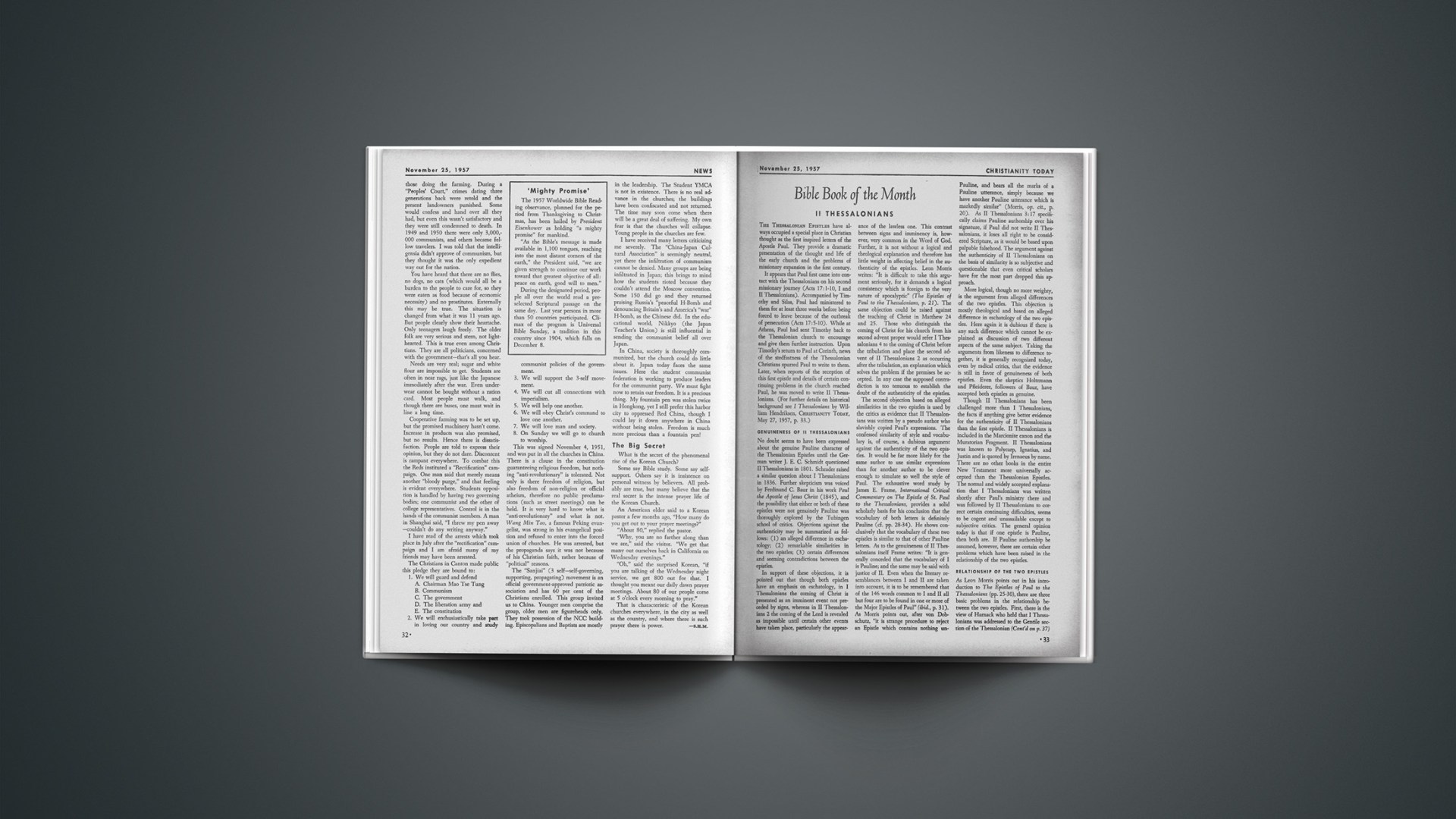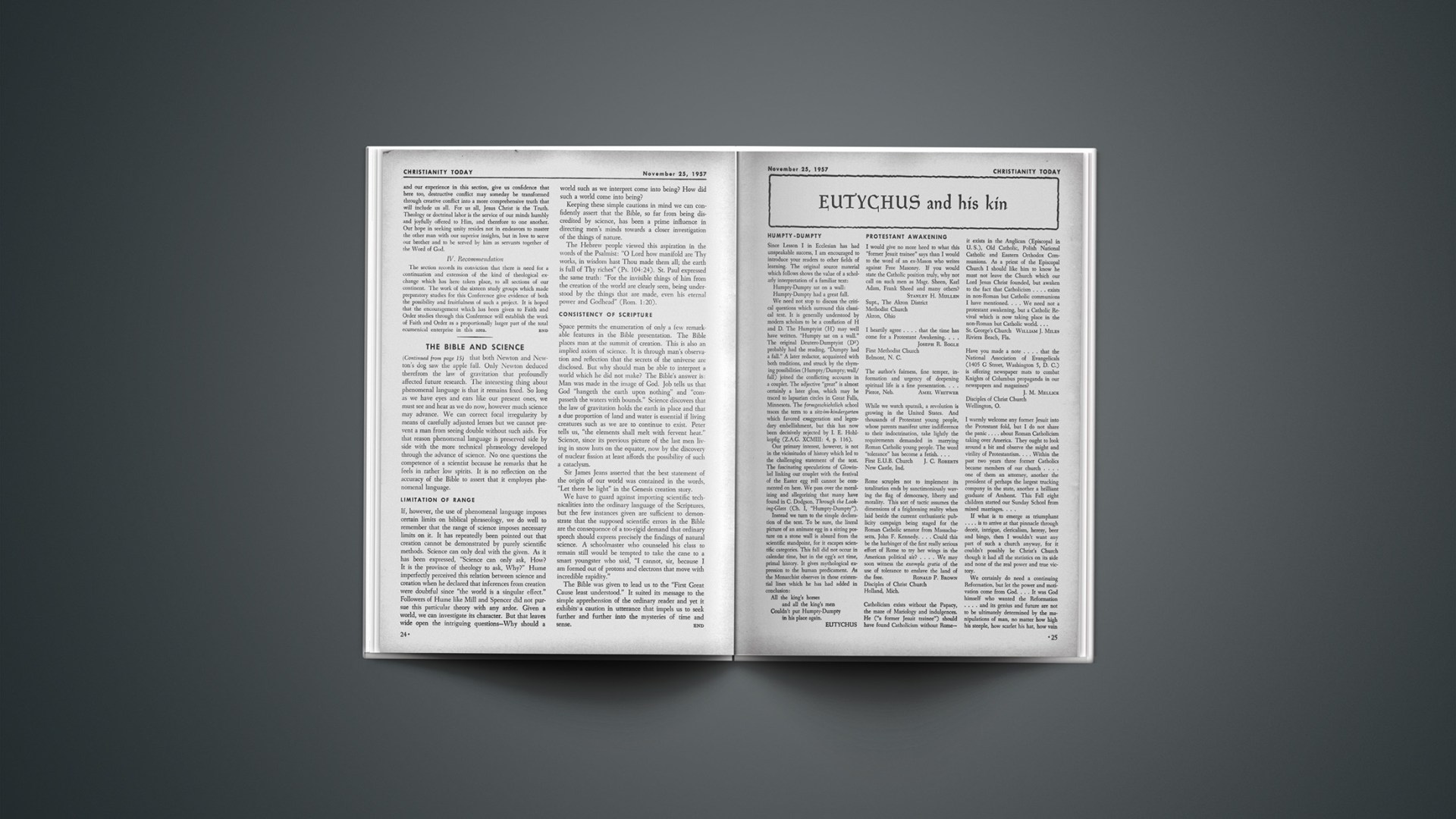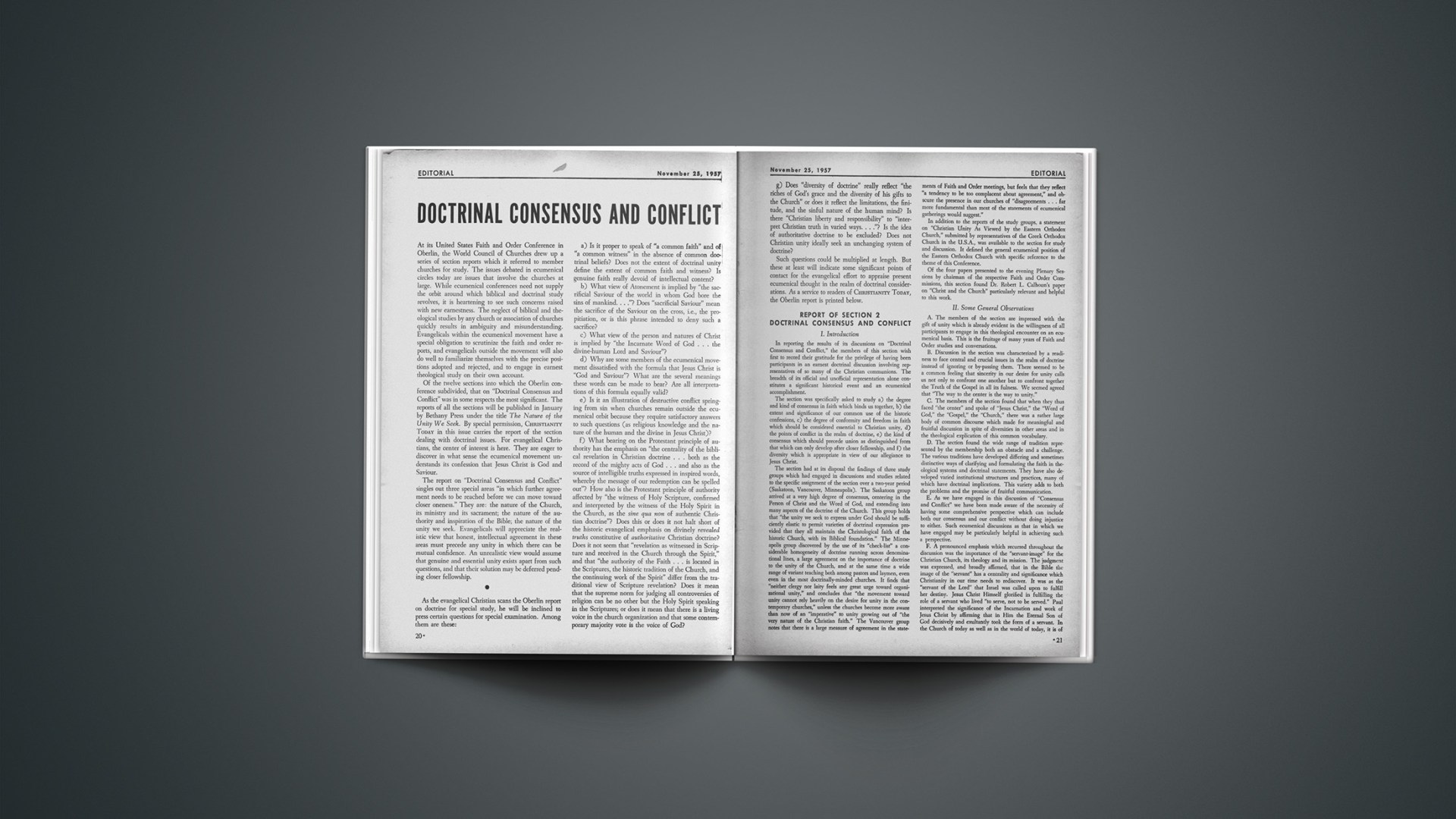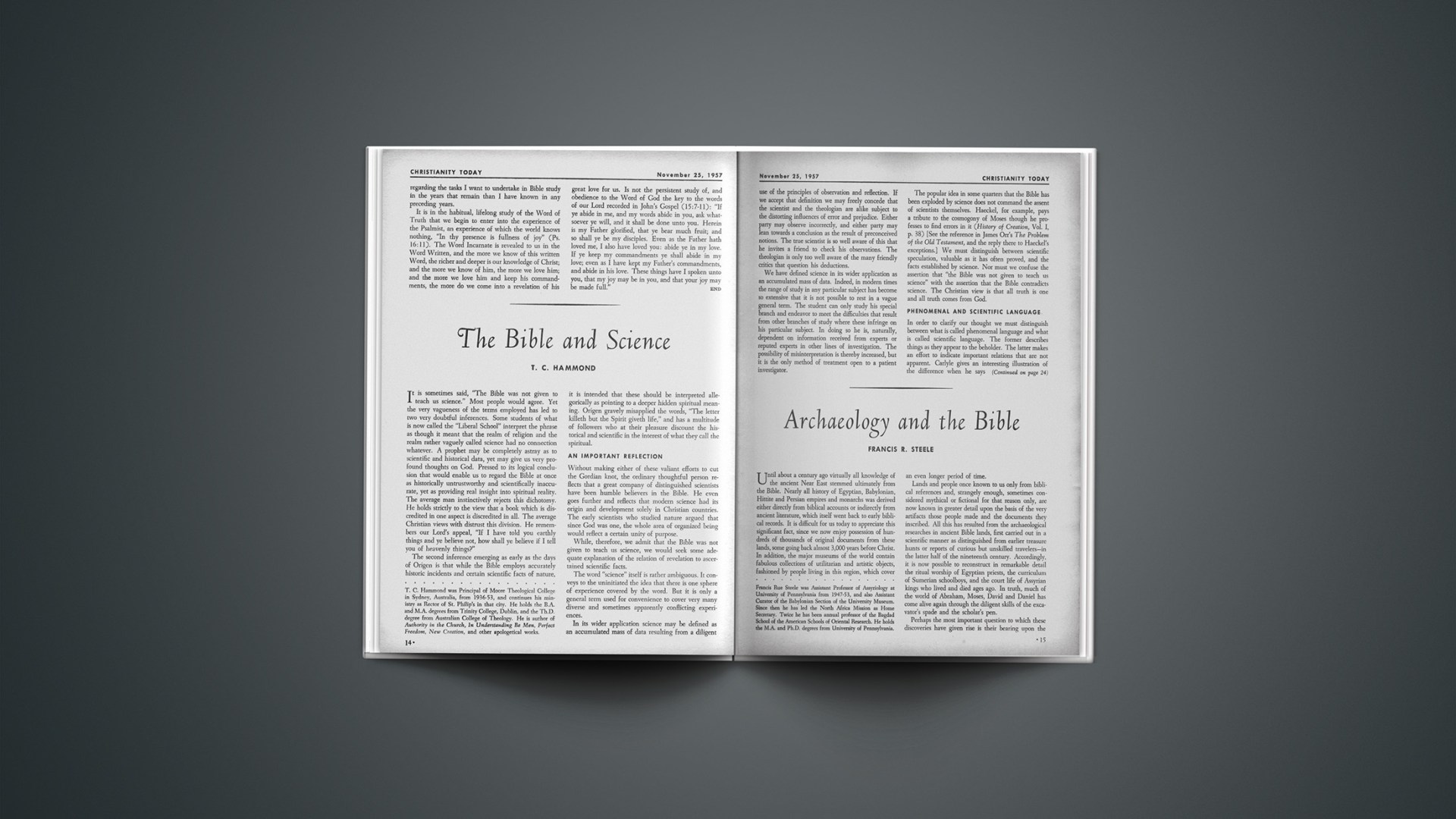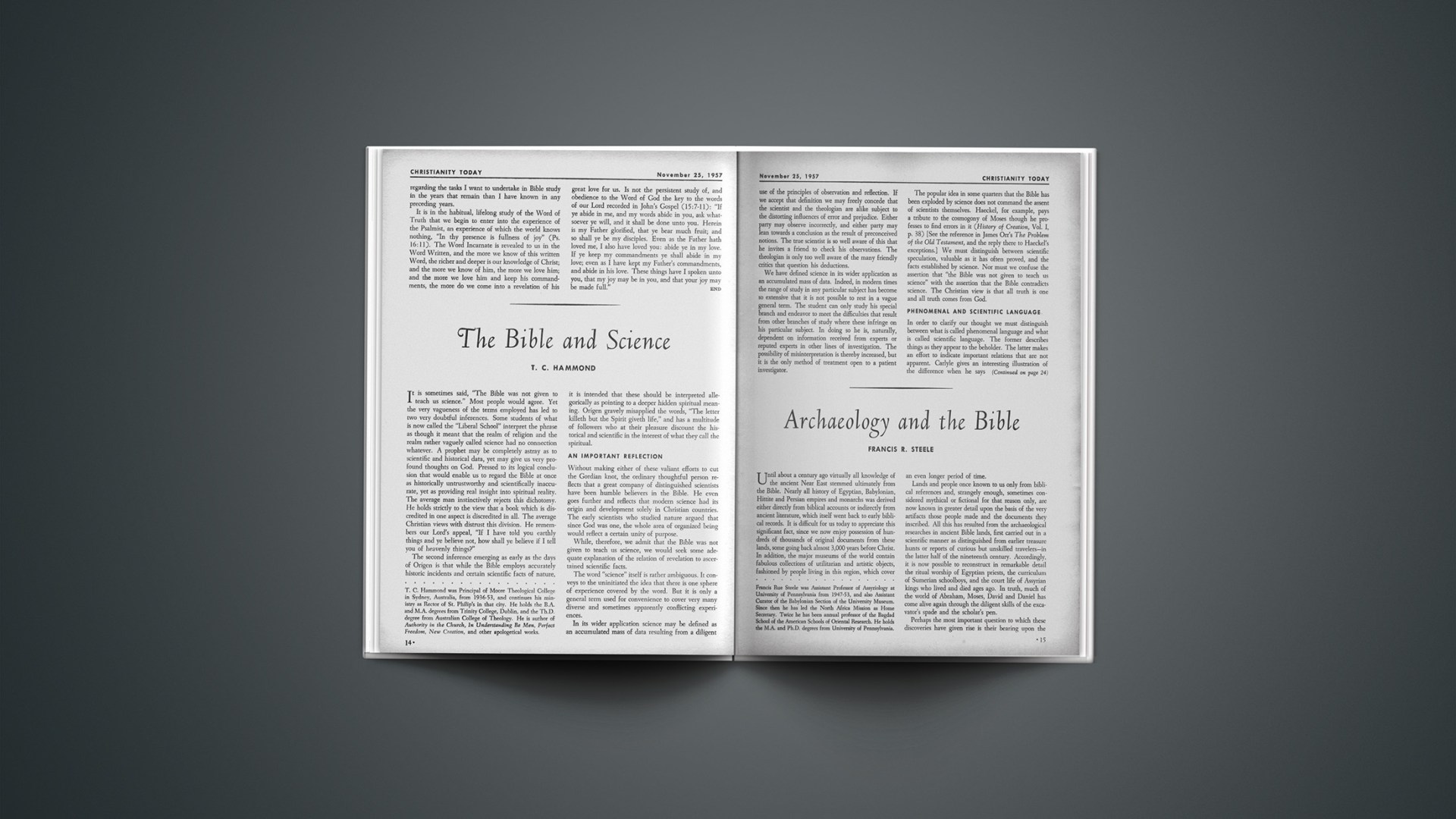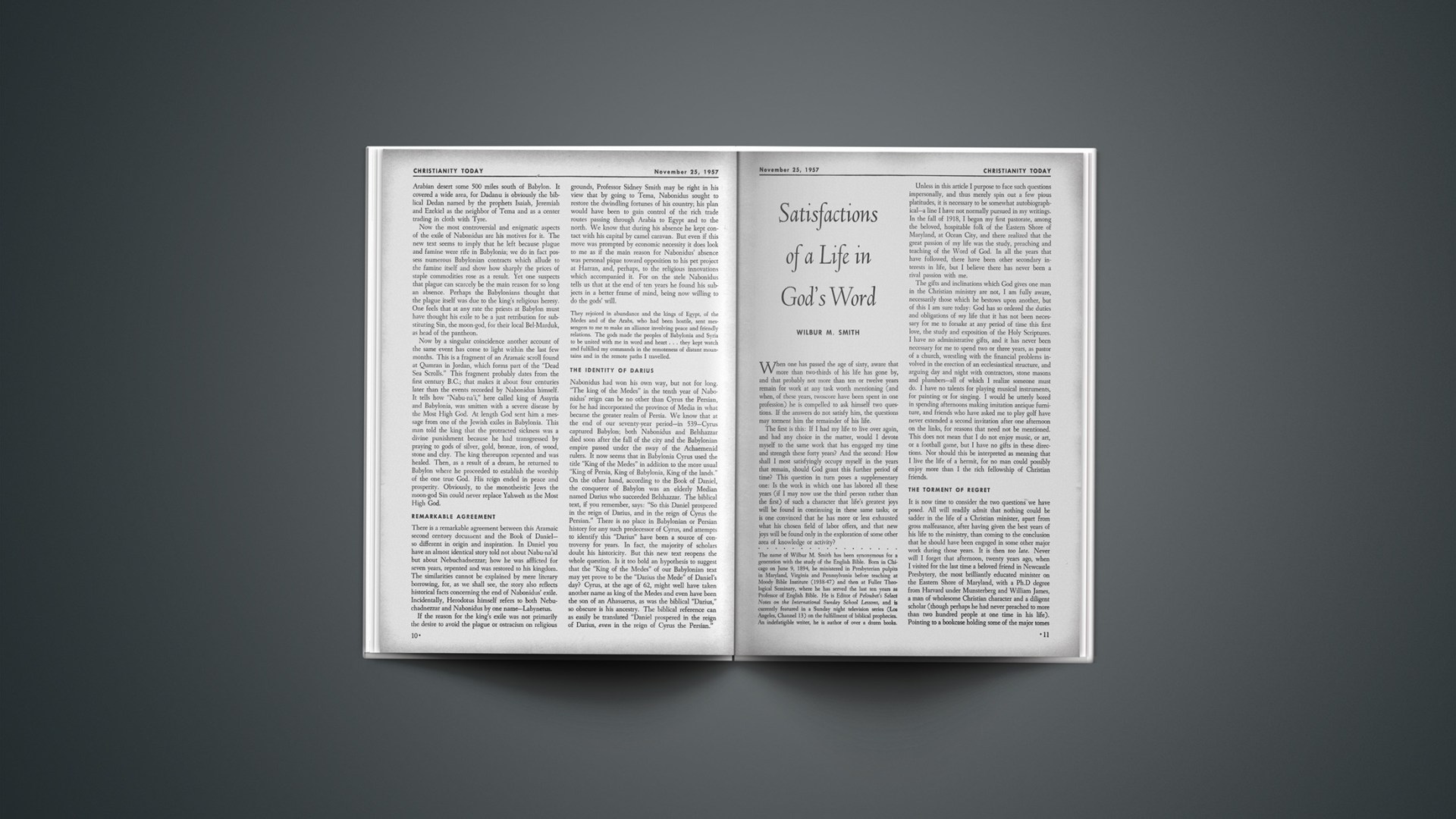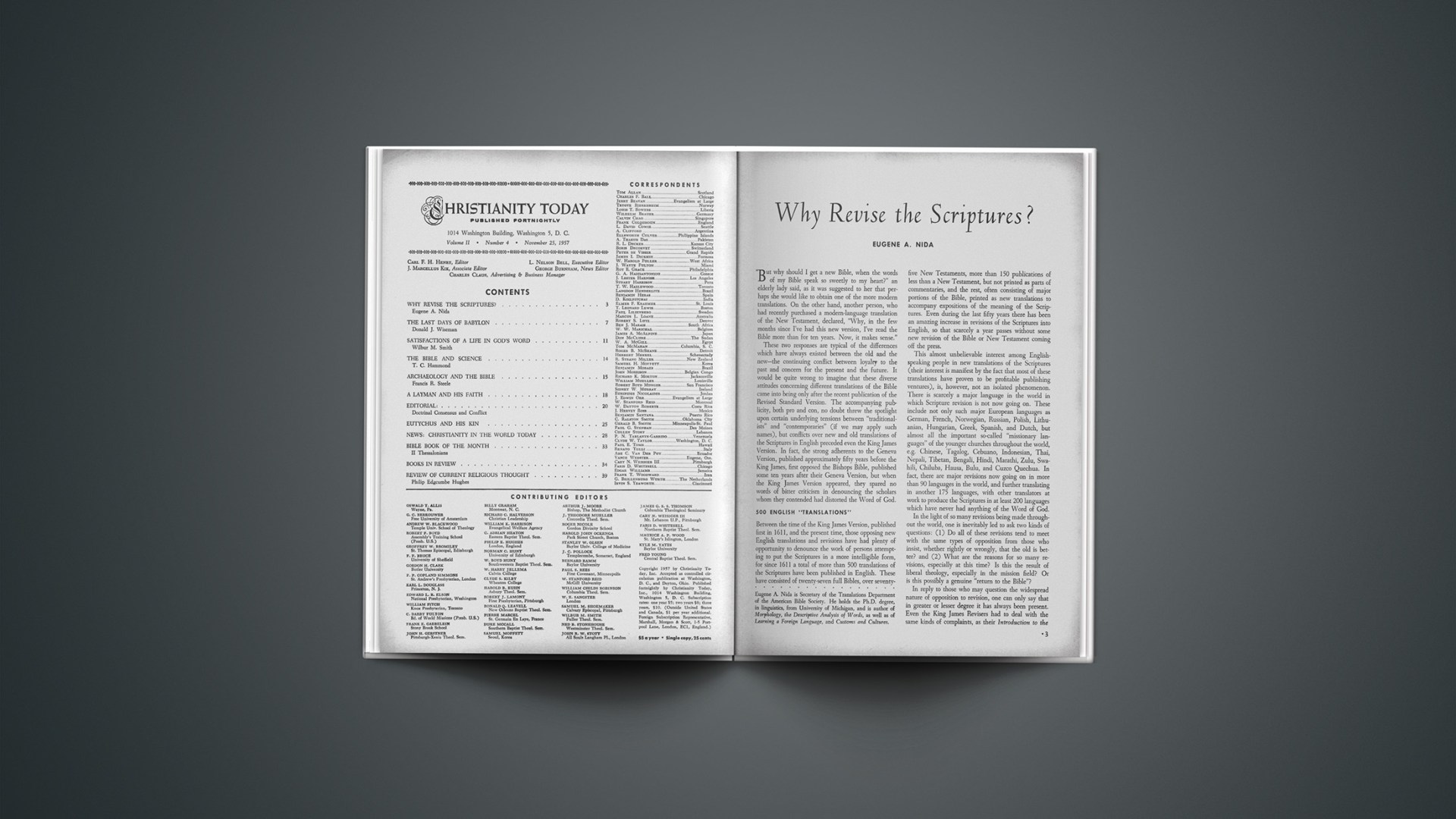The Thessalonian Epistles have always occupied a special place in Christian thought as the first inspired letters of the Apostle Paul. They provide a dramatic presentation of the thought and life of the early church and the problems of missionary expansion in the first century.
It appears that Paul first came into contact with the Thessalonians on his second missionary journey (Acts 17:1–10, I and II Thessalonians). Accompanied by Timothy and Silas, Paul had ministered to them for at least three weeks before being forced to leave because of the outbreak of persecution (Acts 17:5–10). While at Athens, Paul had sent Timothy back to the Thessalonian church to encourage and give them further instruction. Upon Timothy’s return to Paul at Corinth, news of the stedfastness of the Thessalonian Christians spurred Paul to write to them. Later, when reports of the reception of this first epistle and details of certain continuing problems in the church reached Paul, he was moved to write II Thessalonians. (For further details on historical background see I Thessalonians by William Hendriksen, CHRISTIANITY TODAY, May 27, 1957, p. 33.)
Genuineness Of II Thessalonians
No doubt seems to have been expressed about the genuine Pauline character of the Thessalonian Epistles until the German writer J. E. C. Schmidt questioned II Thessalonians in 1801. Schrader raised a similar question about I Thessalonians in 1836. Further skepticism was voiced by Ferdinand C. Baur in his work Paul the Apostle of Jesus Christ (1845), and the possibility that either or both of these epistles were not genuinely Pauline was thoroughly explored by the Tubingen school of critics. Objections against the authenticity may be summarized as follows: (1) an alleged difference in eschatology; (2) remarkable similarities in the two epistles; (3) certain differences and seeming contradictions between the epistles.
In support of these objections, it is pointed out that though both epistles have an emphasis on eschatology, in I Thessalonians the coming of Christ is presented as an imminent event not preceded by signs, whereas in 2 Thessalonians 2 the coming of the Lord is revealed as impossible until certain other events have taken place, particularly the appearance of the lawless one. This contrast between signs and imminency is, however, very common in the Word of God. Further, it is not without a logical and theological explanation and therefore has little weight in affecting belief in the authenticity of the epistles. Leon Morris writes: “It is difficult to take this argument seriously, for it demands a logical consistency which is foreign to the very nature of apocalyptic” (The Epistles of Paul to the Thessalonians, p. 21). The same objection could be raised against the teaching of Christ in Matthew 24 and 25. Those who distinguish the coming of Christ for his church from his second advent proper would refer 1 Thessalonians 4 to the coming of Christ before the tribulation and place the second advent of 2 Thessalonians 2 as occurring after the tribulation, an explanation which solves the problem if the premises be accepted. In any case the supposed contradiction is too tenuous to establish the doubt of the authenticity of the epistles.
The second objection based on alleged similarities in the two epistles is used by the critics as evidence that II Thessalonians was written by a pseudo author who slavishly copied Paul’s expressions. The confessed similarity of style and vocabulary is, of course, a dubious argument against the authenticity of the two epistles. It would be far more likely for the same author to use similar expressions than for another author to be clever enough to simulate so well the style of Paul. The exhaustive word study by James E. Frame, International Critical Commentary on The Epistle of St. Paul to the Thessalonians, provides a solid scholarly basis for his conclusion that the vocabulary of both letters is definitely Pauline (cf. pp. 28–34). He shows conclusively that the vocabulary of these two epistles is similar to that of other Pauline letters. As to the genuineness of II Thessalonians itself Frame writes: “It is generally conceded that the vocabulary of I is Pauline; and the same may be said with justice of II. Even when the literary resemblances between I and II are taken into account, it is to be remembered that of the 146 words common to I and II all but four are to be found in one or more of the Major Epistles of Paul” (ibid., p. 31). As Morris points out, after von Dobschutz, “it is strange procedure to reject an Epistle which contains nothing un-Pauline, and bears all the marks of a Pauline utterance, simply because we have another Pauline utterance which is markedly similar” (Morris, op. cit., p. 20). As 2 Thessalonians 3:17 specifically claims Pauline authorship over his signature, if Paul did not write II Thessalonians, it loses all right to be considered Scripture, as it would be based upon palpable falsehood. The argument against the authenticity of II Thessalonians on the basis of similarity is so subjective and questionable that even critical scholars have for the most part dropped this approach.
More logical, though no more weighty, is the argument from alleged differences of the two epistles. This objection is mostly theological and based on alleged difference in eschatology of the two epistles. Here again it is dubious if there is any such difference which cannot be explained as discussion of two different aspects of the same subject. Taking the arguments from likeness to difference together, it is generally recognized today, even by radical critics, that the evidence is still in favor of genuineness of both epistles. Even the skeptics Holtzmann and Pfleiderer, followers of Baur, have accepted both epistles as genuine.
Though II Thessalonians has been challenged more than I Thessalonians, the facts if anything give better evidence for the authenticity of II Thessalonians than the first epistle. II Thessalonians is included in the Marcionite canon and the Muratorian Fragment. II Thessalonians was known to Polycarp, Ignatius, and Justin and is quoted by Irenaeus by name. There are no other books in the entire New Testament more universally accepted than the Thessalonian Epistles. The normal and widely accepted explanation that I Thessalonians was written shortly after Paul’s ministry there and was followed by II Thessalonians to correct certain continuing difficulties, seems to be cogent and unassailable except to subjective critics. The general opinion today is that if one epistle is Pauline, then both are. If Pauline authorship be assumed, however, there are certain other problems which have been raised in the relationship of the two epistles.
Relationship Of The Two Epistles
As Leon Morris points out in his introduction to The Epistles of Paul to the Thessalonians (pp. 25–30), there are three basic problems in the relationship between the two epistles. First, there is the view of Hamack who held that I Thessalonians was addressed to the Gentile section of the Thessalonian church and that II Thessalonians was intended for the Jewish section. He believed they were meeting in separate groups and therefore needed separate epistles. As Morris points out, there are insuperable difficulties to this theory in that there is very little support of it and much evidence to the contrary. In view of Paul’s opposition to division as indicated in 1 Corinthians 1:11–17, it would be strange for him to accept such a situation without rebuke. The superscriptions of the two epistles give no basis for distinction in address as they are practically identical, and Harnack had to tamper with the text in order to support his contention.
Some have raised another problem relative to the relation of Silas and Timothy to the written epistles suggesting that possibly one or both of them wrote the epistles with Paid’s authority. This view has little to commend itself and raises far more problems than it solves, especially in view of Paul’s signature on II Thessalonians.
Another lively subject for discussion has been the suggestion that II Thessalonians actually was the first of the two epistles. Morris discusses the arguments by T. M. Manson and Johannes Weiss and concludes in respect to these arguments that “none of these is really convincing” (ibid., p. 28). Taken as a whole, the critical examination of I and II Thessalonians has led only to the strengthened conviction on the part of scholars generally that both epistles are genuinely Pauline as held by the early church and the great majority of scholars today.
Content Of The Epistles
The main purpose of II Thessalonians, like the first epistle, is to give comfort, instruction and exhortation to the young Christians in Thessalonica. In both epistles the coming of the Lord Jesus Christ is a prominent theme of every chapter, but this eschatological emphasis is treated primarily as a practical rather than a theological truth. In the midst of their trial and affliction, the hope of Christ’s imminent return was an expectation which gave them courage and strength.
Though a variety of subjects are considered in the second epistle, it may be outlined as follows: 1:1–12, The Christian Hope in Tribulation; 2:1–12, Coming Divine Judgment upon the Lawless One; 2:13–17, Assurance of Salvation; 3:1–18, Exhortations to Prayer, Love of God and Christian Discipline.
The opening chapter of II Thessalonians begins with a salutation almost identical to the opening words of the first episde. After greeting the Thessalonians in verses 1 and 2, Paul expresses his heartfelt thanks to God for their growing faith, increasing love and patience in their trials. In verses 5–10 he portrays the judgment of God upon the wicked as standing in contrast to the Christian hope of those who are now in tribulation. The chapter concludes with mention of his prayers for them that they might fulfill the will of God and that the Lord Jesus Christ might be glorified in them.
The classic passage of 2 Thessalonians 2:1–12 has long been a point of departure among expositors of Scripture. According to the opening verses, it appears that the Thessalonians had heard as from Paul that they were already in the Day of the Lord, a time of divine judgment upon the wicked. This teaching Paul denies, asserting that it came neither by a spirit, nor by an oral word from him nor by a letter supposedly written by Paul. In opposition to this erroneous teaching, Paul states that before this time of divine judgment there must come first a departure from God and a revelation of the lawless one, the anomos. As Morris asserts (ibid., p. 126), the Greek here points to a specific falling away, literally, the departure or apostasia, as if the Thessalonians had already had instruction on this point, possibly a reference to 1 Thessalonians 5:1–11. The reference, therefore, would be to an apostasy immediately preceding the second advent. Scholars holding to posttribulationism find this passage coinciding with Matthew 24 picturing events immediately preceding the glorious appearing of the Lord. Pretribulationists assign the passage to the same time but believe that the rapture of the church occurs before this period. If the Thessalonians had been taught an imminent return of Christ to be followed chronologically by the judgments on the wicked, it understandably would have brought consternation to them to be taught that they were already in that time of divine wrath.
One of the major problems of II Thessalonians is the statement in verses 6–8 that the lawless one cannot be revealed until a certain restraint be lifted. Relative to the expression “ye know what withholdeth” (v. 6), Morris states succinctly, “We do well to bear in mind that the Thessalonians did know and we do not” (p. 129).
Exegetical problems abound in this difficult portion of II Thessalonians. The most popular identification, common to posttribulationism, is to see a reference to the Roman Empire in this restraining force to lawlessness. Others refer it to the force of law and government in general to maintain order, traced to some extent to the continued influence of Roman law and legal systems of other political states. Still another point of view is to refer the restraint to angelic agencies or to Satan. Others have traced it to divine agency itself, either to God in general, in his providential dealings in the world or specifically to the Holy Spirit. Pretribulationists find an argument here in support of their position by identifying the restrainer as the Holy Spirit taken up with the church, i.e., resuming the forum of ministry to the world which obtained before Pentecost.
The prophecy is specific, however, that when the restraint is lifted the anomos will be revealed, working with the power of Satan, deceiving the unrighteous and causing them to believe a lie. By contrast, even though in persecution the Thessalonian Christians were far better off with Christian hope than the wicked were without present trial.
A practical section of exhortation immediately follows this eschatological portion. The Thessalonians are assured of their salvation through sanctification of the spirit and belief of the truth (2:13). Paul exhorts them to stand fast in their Christian convictions as given to them both in Paul’s oral ministry and in his written letters (v. 16). Chapter 2 concludes with a prayer for their comfort and for their establishment in the hope that is theirs in Lord Jesus Christ.
The concluding chapter of II Thessalonians combines various exhortations, the first of which is a command for them to pray for Paul that his message of the gospel may be freely preached and that he himself might be delivered from wicked men. He states his own trust in God as one who is faithful not only to Paul but to the Thessalonians and expresses confidence in them that they will obey his exhortations and that the Lord in answer to prayer will direct their hearts into deepening love for God and patient waiting for the coming of the Lord.
After this practical exhortation, he turns to the immediate problem which had not been solved by his first epistle, namely, that some of the Thessalonians had misconstrued the teaching of the Lord’s return as justifying idleness and disorderliness. He commands that they should be disciplined, that they should follow his own example of earning their own living by honest toil, not being weary in well doing. He commands sharply that if any refuse to obey this command that the church should break fellowship with them, thereby impressing upon them the extent of their departure from the will of God. In the concluding salutation he prays that the Lord of peace will give them peace always by all means and be with all of them. As a token of the genuineness of this epistle in contrast to an alleged forged epistle (2:2), Paul signs the letter with his own hand adding, “which is the token in every epistle.”
Literature
Literature on II Thessalonians is in general the same as on I Thessalonians (cf. article on I Thessalonians by William Hendricksen, Christianity Today, May 27, 1957, pp. 33). Of works mentioned by Hendriksen, James E. Frame, A Critical and Exegetical Commentary on the Epistles of St. Paul to the Thessalonians (New York, 1912) is on most points an excellent volume in The International Critical Commentary Series. Also George Milligan, St. Paul’s Epistles to the Thessalonians, (London, 1908) is a classic. Premillenarians rightly consider The Epistle of Paul the Apostle to the Thessalonians by C. F. Hogg and W. E. Vine (second edition, 1929) as the best treatment of both epistles based on the English text but with obvious knowledge of the Greek. Among more recent commentaries may be mentioned Exposition of First and Second Thessalonians, New Testament Commentary by William Hendriksen (Grand Rapids, 1955); the contribution of Leon Morris, The Epistles of Paul to the Thessalonians, Tyndale New Testament Commentaries (Grand Rapids, 1957). For sermonic exposition, The Church in God by Harold J. Ockenga (Westwood, New Jersey, 1956) may be consulted as well as the writer’s own volume The Thessalonian Epistles (1956) which provides a popular exegesis. A worthy commentary based on the Greek text is afforded by the work of Alfred Plummer A Commentary on St. Paul’s Second Epistle to the Thessalonians (London, 1918).
JOHN F. WALVOORD

